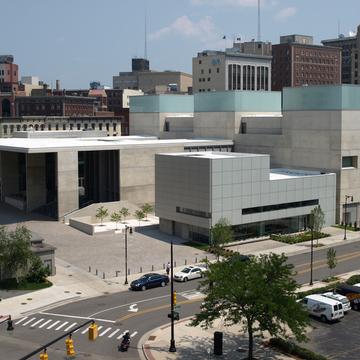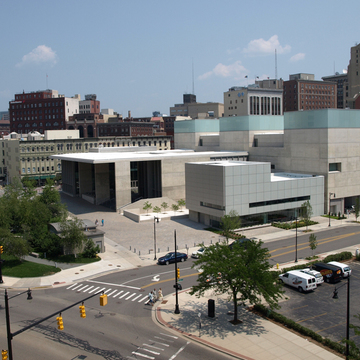You are here
Grand Rapids Art Museum (GRAM)
The Grand Rapids Art Museum (GRAM) stands on the site of the original rapids in the Grand River in Monroe Center, adjacent to the Ecliptic ( KT5). From the park at the northwest, visitors enter over a walk heated with a snowmelt system in winter through a recessed full-height portico into a large lofty lobby that overlooks a reflecting pool to the southwest. Two levels of galleries running the full width of the museum triple the size of exhibition space the museum had in its former quarters in the recycled federal building (Kendall College of Art and Design, formerly U.S. Post Office and Federal Building; KT12). Light admitted through insulated glass windows and skylights with filters and scrim illuminate the interior. Fresh air collected and stored below the building is cooled naturally. Solid concrete walls allow art to be hung without obstruction inside.
To design the minimalist museum the GRAM trustees selected Los Angeles's Kulapat Yantrasast, who directed work for Tadao Ando's Museum of Modern Art in Fort Worth, Texas. Yantrasast said that “his Buddhist heritage prepared him to view life as a circle rather than as a line” ( New York Times March 28, 2007). Thus, he called for recycled and recyclable materials. The architect's philosophy matched the vision of the museum's primary donor, Peter M. Wege.
Wege, an environmentalist and philanthropist whose father founded Steelcase, proposed the building be green, and a gift of $20 million from the Wege Foundation in 2002 stipulated so. Indeed, the museum received a LEED gold rating from the U.S. Green Building Council. The Wege gift made possible the acquisition of the Monroe Center site. A grant from the Grand Rapids Community Foundation initiated the design process.
In 1910 the City Federation of Women's Clubs, charged with promoting municipal beauty, founded the Art Association of Grand Rapids, precursor of the Grand Rapids Art Museum. Mrs. Cyrus E. Perkins, a community cultural leader, and her committee recommended the establishment of an art collection as a basis for a future art museum. In 1924, with a gift from Emily Clark, a local patron of the arts, the association purchased the Greek Revival house at 230 Fulton Street E and established the Grand Rapids Art Gallery, later the Grand Rapids Art Museum. In 1981, the organization moved into the old U.S. Post Office and Federal Building after rehabilitating it for museum purposes, but eventually outgrew this space.
Writing Credits
If SAH Archipedia has been useful to you, please consider supporting it.
SAH Archipedia tells the story of the United States through its buildings, landscapes, and cities. This freely available resource empowers the public with authoritative knowledge that deepens their understanding and appreciation of the built environment. But the Society of Architectural Historians, which created SAH Archipedia with University of Virginia Press, needs your support to maintain the high-caliber research, writing, photography, cartography, editing, design, and programming that make SAH Archipedia a trusted online resource available to all who value the history of place, heritage tourism, and learning.














